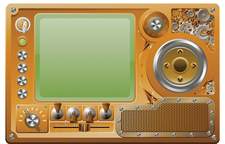Datamancer offers sturdiness with a Steampunk aesthetic
Hands-On

© Lead Image © Christos Georghiou, 123RF.com
Hand-crafted keyboards, computers, and accessories from the imagination of a retro-Victorian artist.
If your home or office is decorated in rich hardwoods, why not have matching computer hardware, rather than futuristic black plastic? – Richard R. Nagy
Richard R. Nagy of Datamancer Enterprises [1] has spent the past few years answering his own question with a line of hand-made keyboards and other computer hardware, much of it with a Victorian-retro or Steampunk aesthetic. His explorations have given him a small but enthusiastic cult following among artists, gamers, and developers.
Nagy has no formal art training. However, he says, "I've always enjoyed drawing, and when I was young I read a lot of fantasy novels and read comic books, copying the art styles of the comic book artists I admired like Todd McFarlane and Jim Lee." At the same time, "I was also very mechanically inclined, and used to disassemble all of my toys and build new ones from the parts, much to the dismay of my mother. I would design custom toys using simple circuits with batteries, switches, motors, and LEDs."
[...]
Buy this article as PDF
(incl. VAT)
Buy Linux Magazine
Subscribe to our Linux Newsletters
Find Linux and Open Source Jobs
Subscribe to our ADMIN Newsletters
Support Our Work
Linux Magazine content is made possible with support from readers like you. Please consider contributing when you’ve found an article to be beneficial.

News
-
SUSE Dives into the Agentic AI Pool
SUSE becomes the first open source company to adopt agentic AI with SUSE Enterprise Linux 16.
-
Linux Now Runs Most Windows Games
The latest data shows that nearly 90 percent of Windows games can be played on Linux.
-
Fedora 43 Has Finally Landed
The Fedora Linux developers have announced their latest release, Fedora 43.
-
KDE Unleashes Plasma 6.5
The Plasma 6.5 desktop environment is now available with new features, improvements, and the usual bug fixes.
-
Xubuntu Site Possibly Hacked
It appears that the Xubuntu site was hacked and briefly served up a malicious ZIP file from its download page.
-
LMDE 7 Now Available
Linux Mint Debian Edition, version 7, has been officially released and is based on upstream Debian.
-
Linux Kernel 6.16 Reaches EOL
Linux kernel 6.16 has reached its end of life, which means you'll need to upgrade to the next stable release, Linux kernel 6.17.
-
Amazon Ditches Android for a Linux-Based OS
Amazon has migrated from Android to the Linux-based Vega OS for its Fire TV.
-
Cairo Dock 3.6 Now Available for More Compositors
If you're a fan of third-party desktop docks, then the latest release of Cairo Dock with Wayland support is for you.
-
System76 Unleashes Pop!_OS 24.04 Beta
System76's first beta of Pop!_OS 24.04 is an impressive feat.

